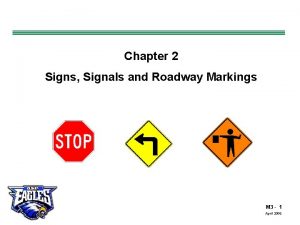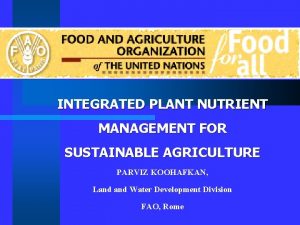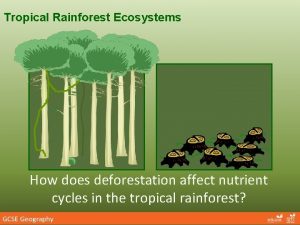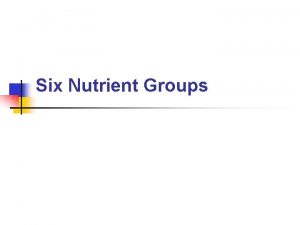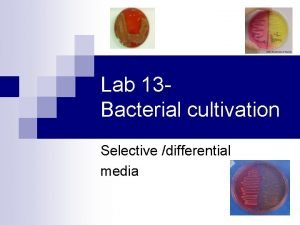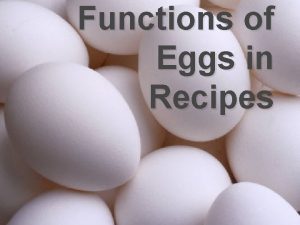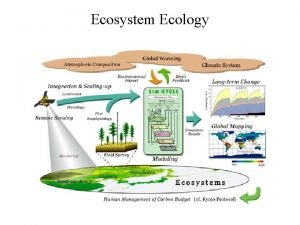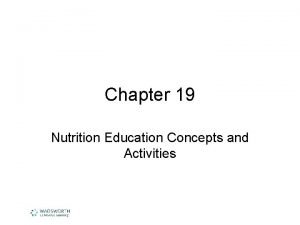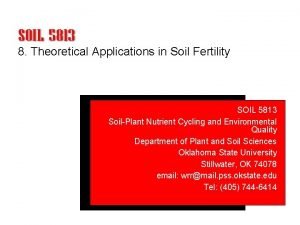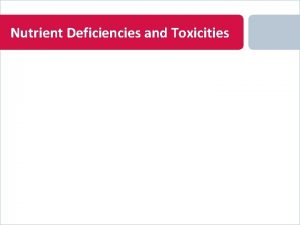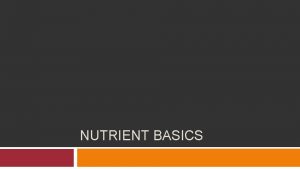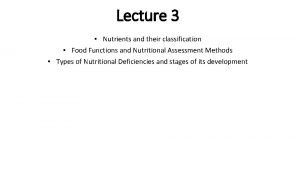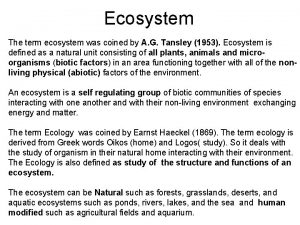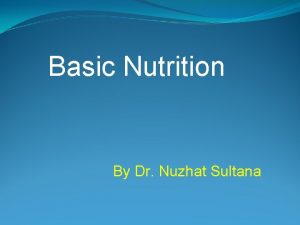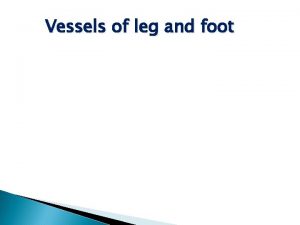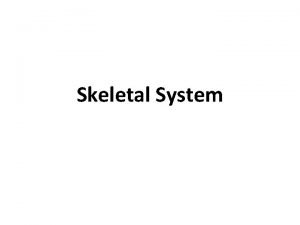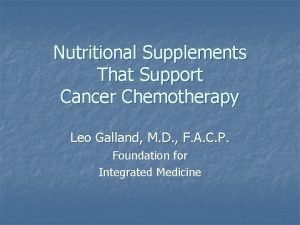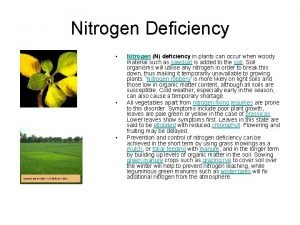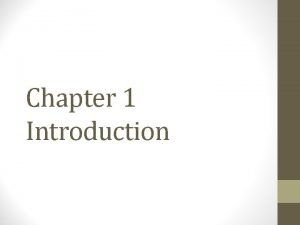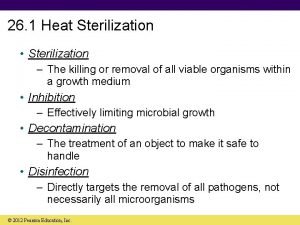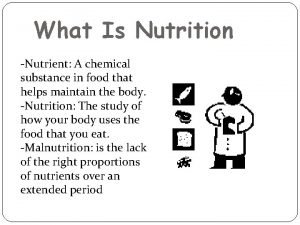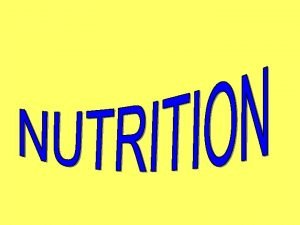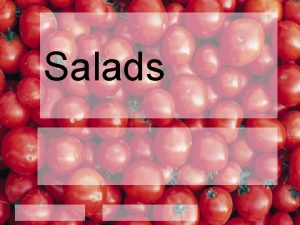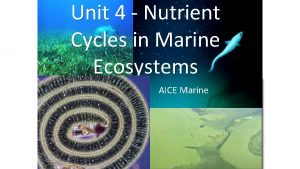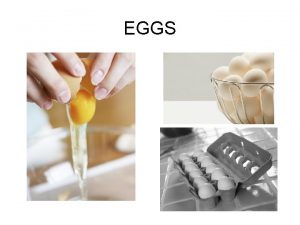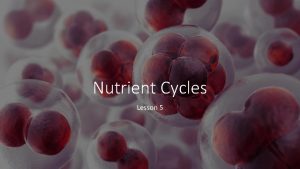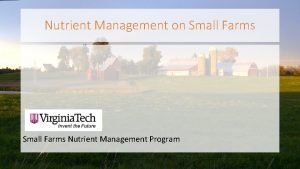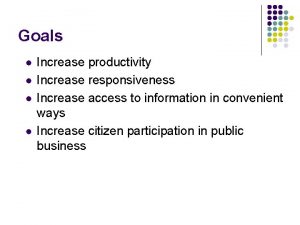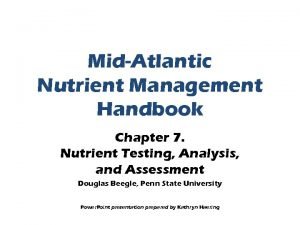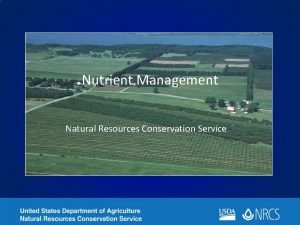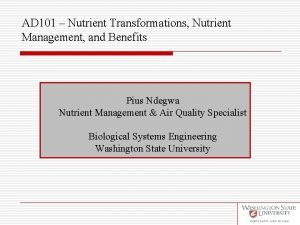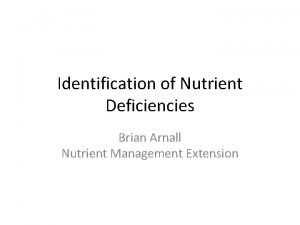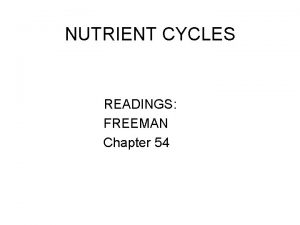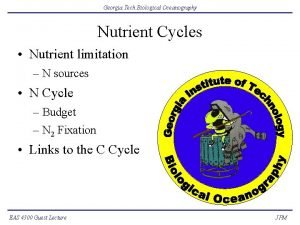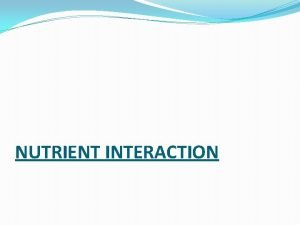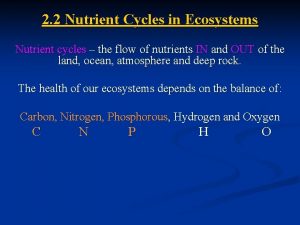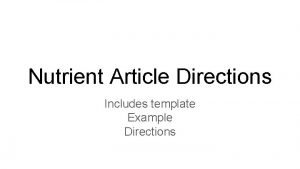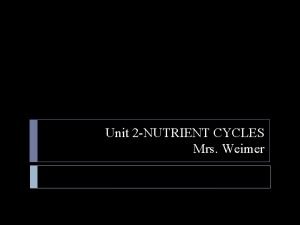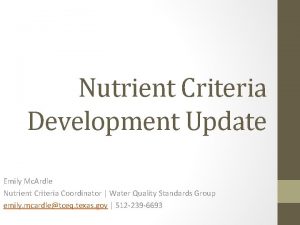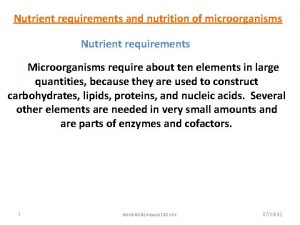Nutrient Management Chapter 16 Increase of course Slower






































- Slides: 38

Nutrient Management Chapter 16




Increase, of course. Slower velocity increases deposition. More organic matter in soil increases adsorption and the soil environment is likely richer in microbes, increasing degradation rate.


Clear cut operation without SMZ Clear cut operation with SMZ

Common sense guidelines on width of buffer strip needed to be effective.

These provide better cover of the soil than just whatever weeds emerge. Thus, there is less effect of raindrop impact on soil detachment and slower runoff velocity means more time for infiltration. Since the crop uptakes soluble N (e. g. , NO 3 -), there is less leaching and if a legume, there is net input of N into the soil so less need for subsequent fertilization. Planted cover crops produce more biomass than native weeds so add more organic matter.



Reduce. This is a matter of coverage of the soil. The more, the better with respect to runoff and erosion.




This study indicated that increasing the time spent in legume both increased corn yields and diminished the benefit / need for N fertilization. The treatments were continuous corn, C-C-C, rotation with soybeans, and a longer term rotation involving meadow, presumably with clover or grass-clover mix.

There are, you know, organic fertilizers that are chemically synthesized.

Common problem is that P / N ratio is larger than the crop needs so long-term use of such fertilizer materials leads to build-up of P in the soil and, therefore, increased potential for P loss to downstream water bodies and their eutrophication.


A lot of the stuff but not much acreage for its beneficial use as a fertilizer.





So funky barrel to left is P-limited. Fix that and wind up with funky N-limited barrel.

Soil testing and plant analysis address the first two nutrient management questions. To some extent also the third –when you need more than one nutrient and two can be applied in the same carrier.






Let’s say there exists a yield curve for crop Y as a function of the level of nutrient X in the soil. Typically, it increases from the origin and levels off with increasing concentration of X in the soil. Thus, there is an evident concentration of X associated with near max yield. Do a soil test and find the concentration of X in your soil is (optimum – your soil) low, so add the difference. Concept of calibration. A lab in NY follows exacting QA / QC and gives excellent analytical results. It will also give you, a La. farmer, recommendations based on the soil nutrient extraction protocol it uses and calibration curves for soil and environmental conditions in NY. Perhaps extraction protocol and calibration curves are not correct for La. soils and environment. Make sense?


Situations for which broadcast is appropriate.

Plants get what they need. Excess fertilizer avoided. If fertilizer element is subject to fixation, concentrated mass of fertilizer in small volume of soil saturates the fixation capacity of the soil there so much of the applied fertilizer remains soluble and available for plant uptake.


This is the current situation in La. and many other states –no soil test for N that serves as the basis for recommendations. Rather, the recommendation is based on field plot experiments that indicate the optimum rate on a crop by soil type basis. The reason for no soil test (like total N, nitrate, etc. ) is the complexity of the N cycle. Recall?

 Indicator media
Indicator media Fluorescent optic yellow sign meaning
Fluorescent optic yellow sign meaning Integrated plant nutrient system
Integrated plant nutrient system T junction of stretcher bond
T junction of stretcher bond Course number and title
Course number and title Chaine parallèle muscle
Chaine parallèle muscle Profunda brachi artery
Profunda brachi artery How does deforestation affect the nutrient cycle
How does deforestation affect the nutrient cycle Six nutrient groups
Six nutrient groups Non fastidious definition microbiology
Non fastidious definition microbiology Emulsifier egg examples
Emulsifier egg examples Nutrient cycle in the serengeti
Nutrient cycle in the serengeti Deciduous woodland nutrient cycle
Deciduous woodland nutrient cycle Foods used in nutrition activities should be nutrient-dense
Foods used in nutrition activities should be nutrient-dense Bray nutrient mobility concept
Bray nutrient mobility concept Energy in trophic levels
Energy in trophic levels How does a plant resist disease and pests journey 2050
How does a plant resist disease and pests journey 2050 Nutrient deficiency
Nutrient deficiency Nutrient basics
Nutrient basics Classification of nutrients
Classification of nutrients Student handout 3 crossword puzzle journey 2050
Student handout 3 crossword puzzle journey 2050 Who coined ecosystem
Who coined ecosystem Defination of nutrients
Defination of nutrients Biogeochemical cycles apes
Biogeochemical cycles apes Posterior tibial arter
Posterior tibial arter Nutrient artery
Nutrient artery Tamoxifen nutrient depletion
Tamoxifen nutrient depletion Nutrient deficiency in tomatoes
Nutrient deficiency in tomatoes Nutrient interactions
Nutrient interactions Brays nutrient mobility concept
Brays nutrient mobility concept Nutrient agar plate
Nutrient agar plate Chemical substance in food that helps maintain the body
Chemical substance in food that helps maintain the body What is fat made of
What is fat made of A main dish salad must contain which nutrient
A main dish salad must contain which nutrient Gersmehl diagrams
Gersmehl diagrams Nutrient cycles in marine ecosystems
Nutrient cycles in marine ecosystems What nutrient cushions vital organs
What nutrient cushions vital organs Interfering agent eggs
Interfering agent eggs Regents biology food chains and energy in ecosystems
Regents biology food chains and energy in ecosystems

